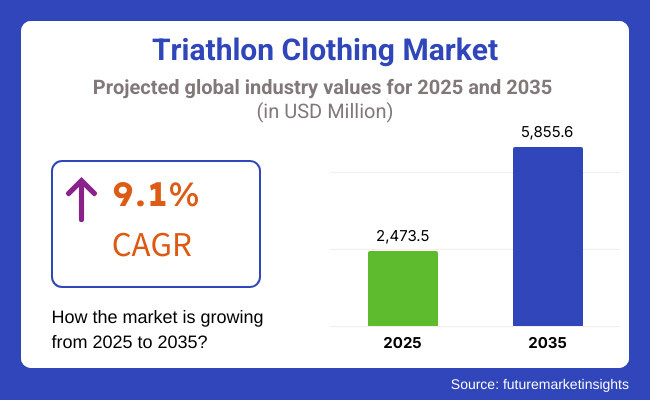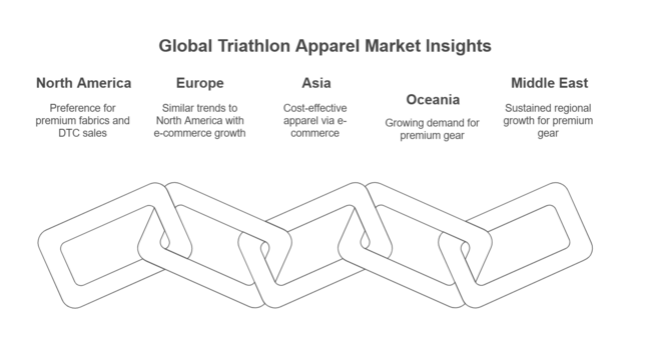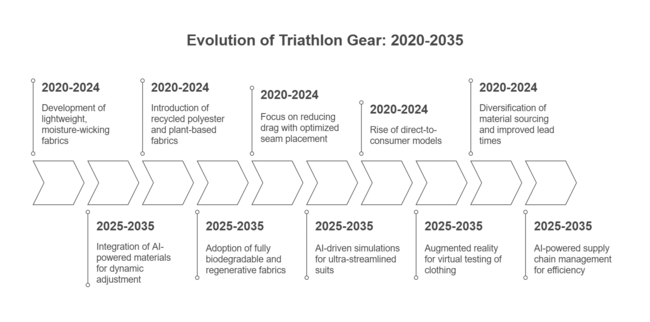The triathlon clothing industry is set for significant growth between 2025 and 2035, driven by rising participation in endurance sports, increasing consumer awareness of performance apparel, and advancements in fabric technology. The market is projected to expand from USD 2,473.5 million in 2025 to USD 5,855.6 million by 2035, reflecting a CAGR of 9.1% during the forecast period.

Key growth factors include a surge in triathlon participation, higher disposable income for sports apparel, and increasing demand for durable, aerodynamic, and water-resistant clothing. Athletes consistently seek apparel that enhances both comfort and performance. Additionally, sustainability will play a crucial role, prompting manufacturers to adopt eco-friendly fabrics and ethical production practices.
Regionally, North America will remain at the forefront of technological advancements, while Europe will lead in sustainability and innovation for athlete-centric apparel. Meanwhile, Asia-Pacific is poised for the fastest growth, fueled by rising sports participation. These trends collectively ensure a dynamic and expanding triathlon clothing market through 2035.
Explore FMI!
Book a free demo
Australia (USD 26.62) and South Korea (USD 15.47) lead purchase behavior in the triathlon clothing on account of the vigorous sporting cultures present in those countries and a strong demand for high-level performance equipment. Australian athletes tend to wear premium, outing-proof triathlon apparel, while South Koreans care more for advanced fabric technology and lightweight gear.
Germany (USD 13.08), the UK (USD 13.91), and Japan (USD 10.55) are among active consumers of triathlon clothing. German and British triathletes want eco-friendly, durable sportswear, while triathletes from Japan want aerodynamic apparel that is precision fit but can also back sportswear technology developments.
China (USD 1.48) and India (USD 0.62) spend very little in per capita consumption, yet they hold greater growth potential. Increasing awareness of endurance sports, rising participation in the triathlon, and supporting infrastructure in sports retail are the market growth-inducing factors in these regions.

Our survey covered 500 respondents on purchasing behavior and pricing trends in various regions: the USA, UK, EU, Korea, Japan, Southeast Asia, China, ANZ, and the Middle East. The findings include,

| Countries | Details |
|---|---|
| United States | Largest triathlon market, high disposable income, strong brand presence, numerous races, and culture of endurance sports. |
| United Kingdom | Strong triathlon culture, high participation, good purchasing power, and established market for sports gear. |
| Germany | High sports participation, large consumer base, well-developed sports retail infrastructure. |
| France | Growing endurance sports scene, hosts major triathlon events, demand for high-quality sports apparel. |
| Japan | Growing interest in triathlons, premium market, preference for high-tech and performance wear. |
| Spain | Moderate disposable income but high sports participation; significant number of triathlons held annually. |
| Italy | More focused on cycling and running, lower triathlon participation than Spain, but good demand for sports fashion. |
| South Korea | Emerging endurance sports market, lower participation in triathlons, high price sensitivity. |
Participation Rates in Triathlons
Disposable Income & Consumer Willingness to Spend
Retail & E-Commerce Penetration
Endurance Sports Culture & Brand Awareness
Competition & Market Saturation
| Lucrative Segments | Non-Lucrative Segments |
|---|---|
| Tri Suits - Preferred by serious triathletes for seamless performance across all three disciplines. Higher price point and premium demand. | Tri Tops - Often bought separately but not as essential as tri suits. Lower market demand. |
| Men’s Segment - Larger consumer base, more established demand, and higher spending on triathlon gear. | Women’s Segment (Except USA & UK) - Growing but still smaller in most regions; less variety in high-end gear. |
| Online Sales - Dominates in the USA, UK, and Germany due to convenience, variety, and discounts. Strong growth in Japan and France. | Offline Sales in Emerging Markets - Limited accessibility in South Korea, Spain, and Italy; lower reach. |
| Tri Shorts - Preferred by casual triathletes and beginners who mix-and-match gear. Moderate demand. | Offline Specialty Stores (Small Cities) - High operational costs, lower foot traffic, and strong online competition. |
With the growth of endurance sports, the triathlon clothing market continues to grow. Athletes demand the best performance geared for speed, aerodynamics, and comfort during swimming, cycling, and running events.
Key players use advanced fabric technologies, compression benefits, and streamlined designs to fulfill these requirements. Material innovations, fit customization, and collaborations with elite athletes are factors that differentiate players in this space from each other in the market. Competition in the market requires brands to apply technology and research for performance apparel enhancement.
Market Share Analysis by Company
| Company Name | Estimated Market Share (%) |
|---|---|
| Zone3 Ltd. | 16-22% |
| 2XU | 14-20% |
| Zoot Sports | 10-16% |
| Pearl Izumi | 8-12% |
| Orca | 6-10% |
| Other Companies (combined) | 30-40% |
| Company Name | Key Offerings/Activities |
|---|---|
| Zone3 Ltd. | Specializes in high-performance triathlon wetsuits, compression wear, and aerodynamic race suits. Focuses on hydrodynamic efficiency and flexibility. |
| 2XU | Produces compression-based triathlon gear, enhancing endurance and muscle recovery. Leverages fabric technology for moisture-wicking and breathability. |
| Zoot Sports | Develops triathlon-specific apparel with innovative chamois padding and seamless construction. Invests in athlete-centered design and long-course endurance comfort. |
| Pearl Izumi | Designs lightweight and durable triathlon apparel with a focus on aerodynamics and temperature regulation. Expands sustainable product lines. |
| Orca | Offers advanced wetsuits and triathlon suits, emphasizing buoyancy and hydrodynamics. Incorporates eco-friendly materials and athlete-driven R&D. |
Zone3 Ltd. (16% to 22%)
Zone3 retains a leading position in the high-performance triathlon apparel market, with an emphasis on wetsuits, compression wear, and aerodynamic race suits. Its focus is on innovation regarding hydrodynamic efficiency and comfort to the athlete; as a general strategy, Zone3 partners with professional triathletes to refine product design and therefore ensure first-rate performance.
Sustainability efforts include the use of eco-friendly neoprene and biodegradable packaging. The brand enhances its market presence through expansion across borders and through e-commerce.
2XU (14% to 20%)
2XU dominates compression-based triathlon apparel, which aids athletes in improving endurance and muscle recovery. State-of-the-art fabric technologies, moisture-wicking materials, and thermoregulation are just a few of the technologies invested in by the company.
2XU then augments its presence through sponsorship deals with professional athletes and sporting institutions. The company has begun integrating digital measurement systems for custom-fitted triathlon suits, which will ensure an optimal performance fit for each individual athlete.
Zoot Sports (10% to 16%)
Zoot Sports designs triathlon-specific apparel for long-distance racing. The company emphasizes athlete-centered design that prioritizes comfort and efficiency over long hours of racing. Zoot's apparel incorporates seamless construction, advanced chamois padding, and fast-drying materials.
The brand seeks to expand through direct-to-consumer sales while simultaneously strengthening retail partnerships in North America and Europe.
Pearl Izumi (8% to 12%)
Pearl Izumi continues to compete in making lightweight and aerodynamic triathlon clothes. The company's emphasis on enhanced speed and endurance comes through integration of temperature-regulating fabrics and aerodynamic paneling.
Pearl Izumi's expansion into product lines made from sustainable and recycled materials further shows the brand's commitment to environmental responsibility. Digital marketing campaigns and interactive outreach to athletes further enhance brand loyalty.
Orca (6% to 10%)
Orca focuses on triathlon wetsuits and race suits, using research-driven design to elevate buoyancy, flexibility, and hydrodynamics. Eco-friendly materials are developed by the company to maintain a lesser environmental impact without compromising the products' high-performance standards.
Orca invests in product testing executed by elite triathletes with the aim of improving the design of its suits for optimum race conditions. The brand excels by getting involved in sponsorships throughout the world and into sales channels on the internet.
Several other companies continue to make a significant impact in the triathlon clothing market by providing niche products at alternative price points. These competing companies focus on niche innovations, affordability, and unique design tendencies.
The Global Triathlon Clothing industry is projected to witness a CAGR of 9.1% between 2025 and 2035.
Global Triathlon Clothing industry stood at USD 2,473.5 million in 2025.
The Global Triathlon Clothing industry is anticipated to reach USD 5,855.6 million by 2035 end.
North America is expected to record the highest CAGR, driven by increasing participation in triathlons and rising demand for high-performance apparel.
Zone3 Ltd., 2XU, Zoot Sports, Pearl Izumi, Orca, and many more signifying the key players operating in the Global Triathlon Clothing industry.
Coffea Arabica (Coffee) Seed Oil Market - Trends, Growth & Forecast 2025 to 2035
Dog Collars, Leashes & Harnesses Market Analysis by Dog Collars, Dog Leash, Dog Harness, Material Type, Distribution Channel and Region Through 2025 to 2035.
Cat Toys Market Analysis by Product Type, Material Type, Sales Channel, End-User, Application and Region Through 2035
Baby Swing Market Analysis by Seat Type, Sales Channel, End User, and Region, Forecast through 2035
Anti-Pollution Hair Care Market Analysis by Product Type, Packaging Type, and Region - Trends, Growth & Forecast 2025 to 2035
Electric Toothbrush Market by Product Type, Price, Head Movement, Sales Channel, and Region - Trends, Growth & Forecast 2025 to 2035

Thank you!
You will receive an email from our Business Development Manager. Please be sure to check your SPAM/JUNK folder too.